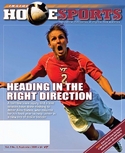The compliance corner is changing its format this year. Instead of educating on what we do, as we did last year, we want to hear from you and answer your questions concerning the governance of our athletics department. Have a question? Please send it to hokipoki@vt.edu and we’ll answer it in upcoming issues.
Now, here are a couple of questions that we’ve received from Tech alums and fans over the past few months, with responses from Tim Parker, the department’s senior assistant AD for compliance:
Q: “From what I’ve learned over the Internet, Darren Evans is not going to be able to get a sixth year and will lose a year because of his torn ACL. Why would the NCAA not show some compassion and give a player in this situation an additional year?” - Rhonda, Martinsville, Va.
TP: “Many people have asked that same question in light of Darren’s injury. The NCAA rule is pretty much straightforward on this. Basically, a student-athlete has to miss two seasons for circumstances beyond his/her control. It could be related to injuries, or maybe missing seasons because of an illness in the family. Something like that.
“But a straight redshirt year does not constitute circumstances beyond one’s control. A student-athlete elects to redshirt, often at the encouragement of the coaching staff. In an overwhelming majority of the time, a redshirt year is justified and beneficial to the student-athlete because it allows him or her to get bigger and stronger and more mature and to adjust to the academics side without the pressure of competing.
“But again, by the NCAA’s definition, a redshirt year is not beyond one’s control. So in Darren’s case, he would not be able to receive a sixth year based on his current collegiate history.”
(Editor’s note: NCAA bylaw 30.6.1.1 states that student-athletes can also receive their sixth year of eligibility for other circumstances beyond their control, such as:
• Life-threatening or incapacitating injury or illness suffered by a member of the student-athlete’s family, which is clearly supported by medical documentation.
• Clearly erroneous academic advice provided to the student-athlete from a specific academic authority from a collegiate institution regarding the academic status of the student-athlete or prospective student-athlete, which directly leads to that individual not being eligible to participate
• Natural disasters (e.g. earthquake, flood)
• Extreme financial difficulties as a result of a specific event (e.g. layoff, death in the family) experienced by the student-athlete or by an individual upon whom the student-athlete is legally dependent, which prohibit the student-athlete from participating in intercollegiate athletics.)
Q: “I was curious about something. How many student-athletes at Virginia Tech work during the summers? I know the NCAA changed the rule on this several years ago.” - Becky, Richmond, Va.
TP: “Actually, the NCAA rule that was changed was related to student-athlete employment during the academic year, but I’ll get to that in a minute. As far as summer employment, 261 of the 544 student-athletes currently listed as active on team rosters were employed for some period of time during summer 2009 (just under 48%). Many of these student-athletes also work during the break between semesters.
“The current rules governing student-athlete employment are consistent throughout the calendar year, and are minimal. Basically, there are three situations which could create a problem: a student-athlete was paid for work they did not do, a student-athlete was paid an overly generous rate for work done, or a student-athlete was given additional compensation by an employer simply as a result of their athletics reputation, fame, personal following, etc. The athletics department will be held accountable in the event that any of these three situations occur. As with many NCAA regulations, we rely on the good sense and sound judgment of Virginia Tech fans and boosters; in this case, those who are in a position to hire or compensate Hokie student-athletes.
“Now, with regard to employment during the fall and spring while school is in session, NCAA rules have been amended twice during this decade. The more strict limitations that were previously in existence have been removed, leaving simply the three requirements listed above. Due to the intense time demands of school and athletics, the number of student-athletes who choose to work while classes are in session during any given academic year is very small, usually less than 25.”




